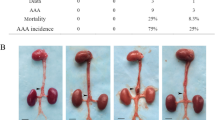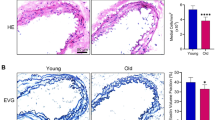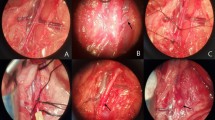Abstract
We studied and compared the efficiency of induction aneurysm in apo E mice by using high fat diet and Ang II. Aneurysm induced in 6 week old male apo E −/− mice by subcutaneous release of Ang II injection for 45 days. Also, aneurysm was induced in three month old male apo E by administration of high fat diet for a period of three months. No difference in body weight in Ang II treated mice. But, increase in body weight and mean arterial blood pressure observed in high fat diet group animals. Highly significant increase in total cholesterol, TG, LDL and significant decrease in HDL level were observed in Ang II treated animals. Significant increase in total cholesterol, but no changes in TG, LDL, HDL levels were observed in high fat diet group. Higher percentage of circulating monocytes was observed in ang II treated group but more number of circulating lymphocytes were observed in high fat diet group in FACS analysis. In histopathology, intimal layer of abdominal aorta was completely replaced by chronic inflammatory cells particularly macrophages (80%) which appeared as foam cells and lymphocytes (20%) in ang II treated animals. Degradation of elastin, infiltration of lymphocytes, chondrocytes and cellular migration towards media were observed in the abdominal aorta of high fat diet group. Real time analysis and immunofluorescence assay supports over expression of Vcam 1 Icam1, MCP 1and MMP2 genes were observed in Ang II treated animals. In immunofluorescence assay, over expression of Mac 3 protein specific for macrophages was observed in abdominal aorta of ang II treated animals, but over expression of CD45.1 & 45.2 proteins specific to lymphocytes were observed in high fat diet group. Based on our observations, Ang II induced aortic aneurysm by recruiting/ proliferating circulating monocytes by up regulating Icam-1, Vcam -1 and MCP-1. Also, ang II involved in degradation of elastin in the abdominal aorta by up regulation of MMP2 to promote agranulocytes migration in the intimal layers. Epithelial cell hyperplasia with accumulation of fatty fluids (cyst) was observed in seminal vesicle and ventral prostate of high fat treated animals. Fatty degeneration, germ cell apoptosis and infiltration giant cells were observed in the testes of high fat diet group. As per available literature these observations were not reported with high fat diet treatments with apo E models. High fat diet induced aneurysm prominently in abdominal, thoracic aorta and extensive plaque formation was observed in femoral and renal arteries. Administration of high fat diet containing cholesterol induced aneurysm in apo E mice model also efficient method to rule out the pathogenesis of aortic aneurysm when compared with angiotensin.










Similar content being viewed by others
References
Thompson RW, Baxter BT (1999) MMP inhibition in abdominal aortic aneurysms. Ann NY Acad Sci 878:159–178
Lederle FA, Johnson GR, Wilson SE, Chute EP, Littooy FN, Bandyk D, Krupski WC, Barone GW, Ballard DJ (1997) Prevalance and association of abdominal aortic aneurysm detected through screening: aneurysm detection and management (ADAM) veterans affair cooperative study group. Ann Intern Med 126:441
Lintin MF, Fazio S (2001) Class A scavenger receptors. Macrophage and atherosclerosis. Curr Opin Lipidol 2:489–495
Ross R (1993) The pathogenesis of atherosclerosis: a perspective for the 1990 s. Nature 362:801–809
Boring L, Gosling J, Cleary M, Charo IF (1998) Decreased lesion formation in CCR2 −/− mice reveals a role for chemokines in the initiation of atherosclerosis. Nature 394:894–897
Nobuhiko A, Suganuma E, Babaev VR, Fogo A, Swift LL, Linton MF, Fazio S, Ichikawa I, Kon V (2008) Angiotensin II amplifies macrophage-driven atherosclerosis. Arterioscler Thrombosis Vasc Biol 24:2143
Gu L, Okada Y, Clinton SK, Gerard C, Sukhova GK, Libby P, Rollins BJ (1998) Absence of monocyte chemoattractant protein-1 reduces atherosclerosis in low density lipoprotein receptor-deficient mice. Mol Cell 2:275–281
Linton MF, Atkinson JB, Fazio S (1995) Prevention of atherosclerosis in apolipoprotein E deficient mice by bone marrow transplantation. Science 267:1034–11038
Fazio S, Babaev VR, Murray AB, Hasty AH, Carter KJ, Gleaves LA, Atkinson JB, Linton MF (1997) Increased atherosclerosis in mice reconstituted with apolipoprotein E null macrophages. Proc Natl Acad Sci USA 94:4647–4652
Collins RG, Velji R, Guevara NV, Hicks MJ, Chan L, Beaudet AL (2000) P-Selectin or intercellular adhesion molecule (ICAM)-1 deficiency substantially protects against atherosclerosis in apolipoprotein E-deficient mice. J Exp Med 191:189–194
Tummala PE, Chen XL, Sundell CL, Laursen JB, Hammes CP, Alexander RW, Harrison DG, Medford RM (1999) Angiotensin II induces vascular cell adhesion molecule-1 expression in rat vasculature: a potential link between the renin-angiotensin system and atherosclerosis. Circulation 100:1223–1229
Iademarco MF, McQuillan JJ, Rosen GD, Dean DC (1992) Characterization of the promoter for vascular cell adhesion molecule-1 (VCAM-1). J Biol Chem 267:16323–16329
Voraberger G, Schafer R, Stratowa C (1991) Cloning of the human gene for intercellular adhesion molecule 1 and analysis of its 5′-regulatory region. Induction by cytokines and phorbol ester. J Immunol 147:2777–2786
Ueda A, Ishigatsubo Y, Okubo T, Yoshimura T (1997) Transcriptional regulation of the human monocyte chemoattractant protein-1 gene. Cooperation of two NF-kappaB sites and NF-kappaB/Rel subunit specificity. J Biol Chem 272:31092–31099
Hajra L, Evans AI, Chen M, Hyduk SJ, Collins T, Cybulsky MI (2000) The NF-kappa B signal transduction pathway in aortic endothelial cells is primed for activation in regions predisposed to atherosclerotic lesion formation. Proc Natl Acad Sci USA 97:9052–9057
Berk BC, Haendeler J, Sottile J (2000) Angiotensin II, atherosclerosis, and aortic aneurysms. J Clin Invest 105(11):1525–1526
Grange JJ, Davis V, Baxter BT (1997) Pathogenesis of abdominal aortic aneurysm: an update and look toward the future. Cariovasc Surg 5:256–265
Lusis AJ (2002) Atherosclerosis. Nature 407:233–241
Acknowledgements
This study was supported by grant in aid from Indian Council of Medical Research (ICMR), Government of India. The project IRIS ID no is 2005-04430.
Author information
Authors and Affiliations
Corresponding author
Rights and permissions
About this article
Cite this article
Gopal, K., Kumar, K., Nandini, R. et al. High fat diet containing cholesterol induce aortic aneurysm through recruitment and proliferation of circulating agranulocytes in apoE knock out mice model. J Thromb Thrombolysis 30, 154–163 (2010). https://doi.org/10.1007/s11239-010-0446-8
Published:
Issue Date:
DOI: https://doi.org/10.1007/s11239-010-0446-8




